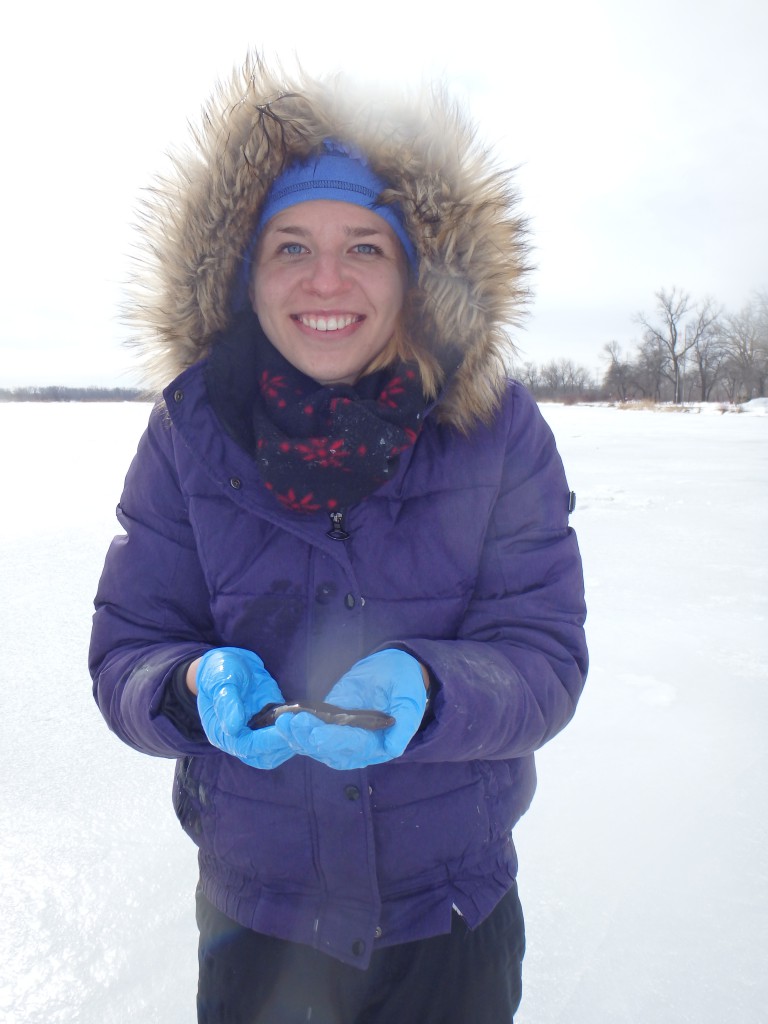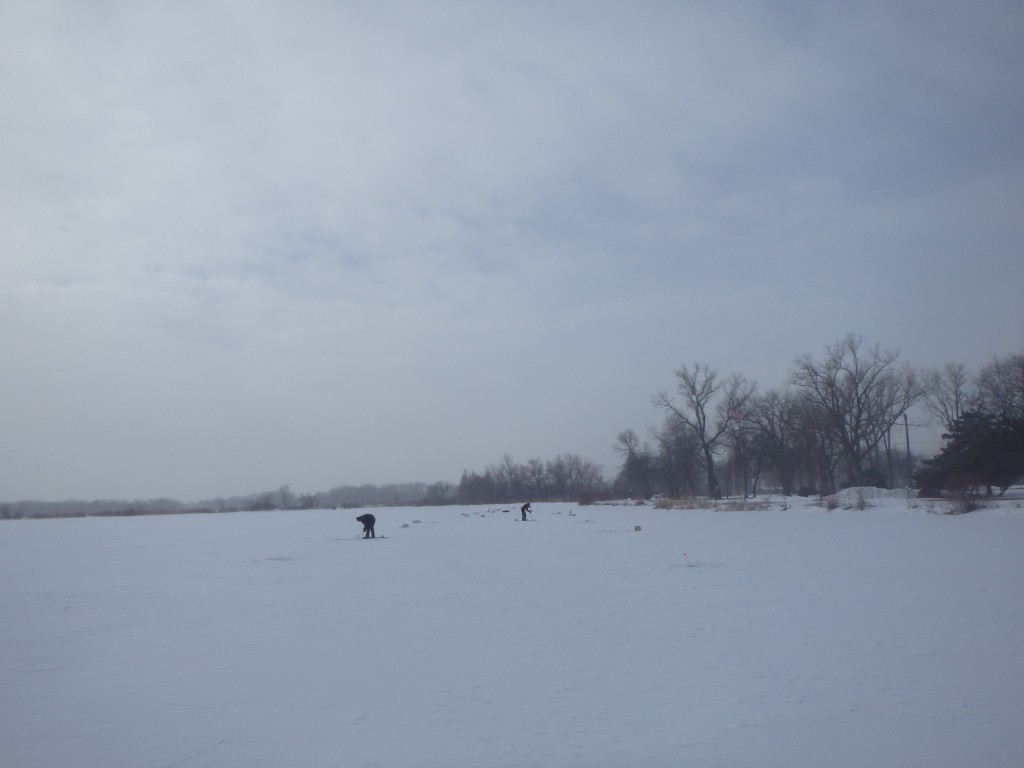
On frigid cold January weekends, my grandpa used to take me ice fishing on Beebe Lake, in Saint Michael, Minnesota. As we sat there quietly on our plastic buckets, waiting for our bobbers to plunge, I remember marveling at all the clusters of people clad in marshmallow jumpsuits, eyes peeled on their 10” holes. In the land of 10,000 lakes, bundling up and hanging out on the ice all day is a tradition, one that every true Minnesotan must participate in each winter.
Last winter 2015, I had the opportunity to put my ice fishing skills to the test in a whole new way when I began my first ever ice mudpuppying adventure. As a master’s student from Southern Illinois University, Carbondale supported by the Shedd Aquarium, my project was to center on the ecology of a large, fully aquatic salamander known as the mudpuppy (Necturus maculosus). Mudpuppies are a protected species in Illinois and are thought to be in decline throughout the Great Lakes region, with potential threats including habitat loss, siltation and pollution, over harvest for bait or by biological supply companies, persecution due to misperceptions that they are poisonous or a threat to game fish populations, and altered food webs. Little is known about mudpuppies and I hope to provide information on their population characteristics, habitat associations, and diet in an ecosystem heavily altered by invasive species including round gobies, rusty crayfish, and zebra mussels.
Despite a long history of heavy industry and pollution, mudpuppies were still known to live in Wolf Lake, a highly modified lake straddling the Illinois – Indiana border near the south shores of Lake Michigan. Wolf Lake might be the best place to study mudpuppies within the Chicago city limits. By mid January, the ice was thick enough out at Wolf Lake that a few audacious fishermen had already set up camp, braving single digit temperatures to enjoy some refuge from the city and hopefully catch a few bass or maybe even a walleye. They watched my team incredulously as we hauled a sled full of metal funnel-type minnow traps, a gas powered ice auger, and a sloshing bucket of fathead minnows bait across the ice and began drilling holes. All reports suggested that winter was a good time to catch mudpuppies. Fishermen rarely catch them during the summer. My team set 30 traps under the ice our first day, carefully placing foam insulation pads over the holes to prevent our traps from becoming frozen beneath the ice. Mudpuppies are more active at night, and at some point during their foraging, we hoped they would find their way into one of our baited traps and remain stuck until we found them in the morning. It just had to work!

The next morning, we trekked across the ice to check our traps, barely able to contain our excitement. We gathered around the first hole and began to chisel out the edges in order to retrieve the trap. Even with the foam insulation, temperatures had plummeted so low the night before that the hole was no longer wide enough to pull out the trap. With a rope dangling through the middle, the hole could not be re-drilled and chiseling out the sides with our small hand-held chiseling tools was our only option. However, each time we tried to pull the trap up, it would get stuck. A half an hour passed before we finally chiseled enough ice away to pull up the trap . . . nothing. At one point, a fisherman wandered over with his Scottie dog and asked us what we were doing. He had heard of people at Wolf Lake occasionally catching mudpuppies on their fishing lines. Intrigued by the project, he recommended using a long-handled chisel instead, or “spud bar.” “Try this instead,” he said, passing me his personal chisel. “Just bury it in the snow bank on that log when you are done for the day!” The next hole only took 10 minutes. Finally, we had the leverage we needed! I guess I hadn’t learned everything during the ice fishing days of my youth! We got to work chiseling and finished checking traps early afternoon. Nothing.
I tried to tell myself that ice mudpuppying must be like fishing, that I should follow the old adage to not get discouraged if you don’t catch a fish your first time. Trying to maintain a positive attitude, we headed back out to the ice the next day and began checking traps once more. Half way through checking traps, I was starting to despair when my team member yelled across the ice, “MUDPUPPY!” I couldn’t believe it. I started running across the ice. When I saw the smiling faces of my fellow ice mudpuppying enthusiasts, I knew immediately that it was okay to celebrate. There in the bucket was a frilly-gilled, rich brown dappled mudpuppy, crawling slowly across the bottom. I think the fishermen hanging out on the lake must have thought we caught a record size walleye or something. They looked pretty baffled when they wandered over, peered in the bucket, and saw a four-legged salamander instead.

By now, I think I have talked to almost all the regulars out at Wolf Lake. Many fishermen take great pride in Wolf Lake, recognizing its value as a biological diversity hotspot within the city limits of Chicago. Each day at Wolf Lake, I have at least a few curious fishermen come by, peer into my buckets, and ask me for the day’s ‘conservation report.’ They often stand and watch for a bit as I record data. I annotate the process, describing how a PIT tag works and explaining the best techniques for ‘burping’ a mudpuppy in order to obtain its stomach contents and figure out what they are eating. I point out prey items that I will later identify in the lab, such as a rusty crayfish claw or a pouch snail.
To date, I have captured 79 mudpuppies at Wolf Lake and had 17 recaptures. I still get excited every time I pull up a trap and find a mudpuppy. I never imagined that I would one day take my ice fishing skills and use them for an amphibian research project . . . in Chicago! I think I have my Grandpa to thank for my thick Minnesota skin and patient and persistent nature. My herpetology friends continuously ask me what I was thinking when I signed up to study an amphibian in Chicago, one that happens to be highly cryptic and most active during the coldest months of the year! It’s not something I ever expected to do, but not many can say they have ever experienced a true winter season of ice mudpuppying. The results of this study will help organizations like the Shedd Aquarium, Army Corps of Engineers, and Illinois Natural History Survey (INHS) better protect mudpuppies and create management plans. Most importantly however, I think this project has started a real dialogue about mudpuppies and a broader one about conservation, public education, and citizen involvement. Numerous staff members and volunteers from Shedd Aquarium, Habitat 2030, and the local Southeast Sportsman’s Club at Wolf Lake have been involved in the project. Together, we chisel ice, share stories, and connect over the wonders of Wolf Lake ice mudpuppying.
Alicia Beattie
Latest posts by Alicia Beattie (see all)
- Mudpuppying in Chicago: My Story - August 10, 2015

Great article! I’ve always loved Wolf Lake and it’s great hearing about the success of this little guy out there.